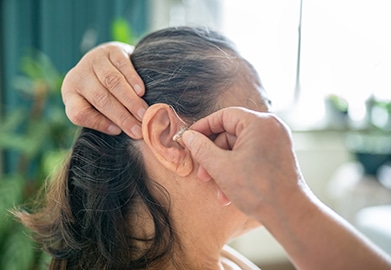The History & Evolution of Phonak Hearing Aids


Since its establishment in 1947 in Switzerland, Phonak has been dedicated to designing and producing state-of-the-art hearing devices for over 70 years. They are renowned globally for the broadest range of hearing care solutions and their technological advancements and achievements.
As a major manufacturer of hearing aids today, it is important to learn how Phonak has managed to grasp this level of excellence and its ladder to success.
Phonak Hearing Aid Achievements, Developments, and Evolution
Phonak has been a pioneer of hearing aids and one of the leading innovators and manufacturers in the industry. This timeline outlines significant landmarks and pivotal moments that contribute to their longevity and highlights their impact on the advancement of digital hearing aids.
1940s to 1980s
In 1947, Chuck Yeager broke the sound barrier in level flight, and in the same year, AG für Elektroakustik was founded with a mission to aid people in breaking their “barrier to hearing.” Three years later, the first portable devices named Phonak Alpina were introduced.
Ernst Rihs acquired the company’s majority shares in 1965, and he renamed the company Phonak AG. Two years later, the Visation Super, a pair of glasses that featured an integrated hearing aid, was launched. This was followed in 1970 by the release of the Phonette, the world’s first behind-the-ear (BTE) hearing aid.
Phonak Holding AG was incorporated in 1985 as Phonak Group’s holding company. In two years, the company moved to their new headquarters in Stäfa as a way to usher in its fourth decade.
1990s
The launch of the Phonica in 1991 marked the start of significant developments. It was the first in-the-ear (ITE) hearing aid concept.
The following year, Phonak launched the PICS, the first-ever digital programmable hearing system with an analog signal processor.
Phonak went public in 1994 and also launched the AudioZoom, which was a pioneering multi-microphone technology. Microlink, the world’s smallest FM receiver, was unveiled in 1996, and in 1997, a new technology centre was opened in Stäfa.
The end of the 90s was marked by the launch of Claro in 1999. Claro was the first fully digital Phonak hearing aid and included an integrated FM receiver.
2000 to 2010
The new decade started with the launch of the MLx. It helped to establish the worldwide standard of FM technology. In 2002, Phonak introduced Supero. It was, at the time, the first super high-power digital product for more severe levels of hearing loss.
2003 saw the launch of SmartLink, an FM transmitter that allowed wearers to enjoy the wireless connectivity of Bluetooth mobile phones for hearing aids.
In 2005, the Savia was launched. It was the first hearing system to take advantage of the full potential of digital technology. A year later, Phonak introduced microPower – a hearing device with canal receiver technology (CRT).
On August 1, 2007, Phonak Holding AG was renamed Sonova Holding AG. However, the brand name Phonak did not change. In the same year, Sonova founded Phonak Acoustic in Lausanne to improve middle ear implants. The CORE platform, which allowed hearing aids to connect to various multimedia devices wirelessly, was also introduced.
2008 presented Naída, the first generation of Phonak hearing aid models designed for severe hearing loss, featuring water-resistant housing. It also included the new SoundRecover technology, which improved the perception of high-frequency signals.
In 2009, Phonak launched both the Audéo MINI, which was the smallest BTE device in the world, and the Audéo SMART, the first hearing aid with wireless functionality.
2010 to 2020
Dynamic SoundField was launched in 2010, which helped to significantly improve the understanding of speech in noisy areas like classrooms. Several Phonak products were awarded the iF product design and GOOD DESIGN awards.
In 2011, the Lyric was launched. It was the first and only 24/7 wearable, waterproof, and completely invisible hearing aid.
2012 saw the introduction of the Quest platform. Based on the exceptional Binaural VoiceStream Technology™, it worked to improve the ability to understand speech by up to 45% in challenging circumstances such as in restaurants or busy shops.
In 2013, Phonak launched Sky Q, a pediatric hearing solution available in a broad colour palette. This gave children the option to mix and match the housing and hook colours to their liking. The launch of Roger technology also bridges the gap in noise and distance by transmitting the speaker’s voice directly to the aids. To add to an already excellent year, Phonak was given the Company of the Year award by the Swiss-British Chamber of Commerce.
The new Venture platform and chip technology launched in 2014 offered twice the processing power while reducing battery usage up to 30%. The Audéo V hearing aid family was introduced, as was Phonak EasyCall, which connects any wireless Phonak hearing aid to any Bluetooth-enabled phone – even older models.
In 2015, the Phonak Virto™ V and Phonak Bolero™ V hearing aid families were introduced.
2016 was an excellent year for Phonak and featured a lot of developments. The Belong platform was introduced and included the Audéo B-R. It was the first hearing aid with an in-built lithium-ion battery that provided up to 24 hours of usable time. It was the fastest charging and longest-lasting rechargeable hearing aid ever produced.
Other products launched include Phonak Naída™ V power hearing instruments, SoundRecover2, which enhanced the ability to hear higher and lower frequencies, Phonak Sky™ V for kids’ and teens’ communication needs, and the Roger™ for Education portfolio.
In 2017, some of the innovative launches included:
- Phonak Audéo B-Direct, which allowed for easy connectivity with any Bluetooth-enabled mobile phone or TV.
- Phonak Virto™ B, the first hearing device with Biometric calibration. The Phonak Virto™ B Titanium was also released. It was made from medical-grade titanium and was the smallest in-the-ear (ITE) hearing aid created by Phonak.
- The Phonak Bolero™ B family, which featured a rechargeable model that could last 24 hours on one charge.
In 2018, new hearing aid families based on the Belong™ platform were introduced. These include the Sky B, Naida B, Vitus, and Vitus+. These devices had an enhanced and comprehensive portfolio for mild to severe hearing loss. Another significant development in 2018 was the launch of the first Contralateral Routing of Signal (CROS) device with a lithium-ion battery. The CROS B-R is ideal for people with single-sided deafness.
2019 saw the release of the Phonak Marvel™, an exceptional hearing aid that enhanced speech understanding and lessened the listening effort required in noisy areas. The device can also stream music from Android smartphones, iPhones, and most Bluetooth devices. They also feature real-time voice-to-text transcripts of phone calls through the use of apps.
Phonak Paradise™, introduced in 2020, improves hearing performance with new hardware and added features. The device offers crisp, natural sound, excellent speech understanding, and dynamic noise cancelling. Users can also discover tailor-made solutions with the new myPhonak 4.0 app and universal connectivity.
Contact Us for Phonak Hearing Aids & Accessories
Everyone deserves good hearing, and Phonak products combine excellent speech recognition with the latest hearing aid technology. For any of your hearing concerns, please reach out at 416-207-9711 or book a test with us online. Our team of experts is available to help answer questions and find the right product for you.
Also Read:


